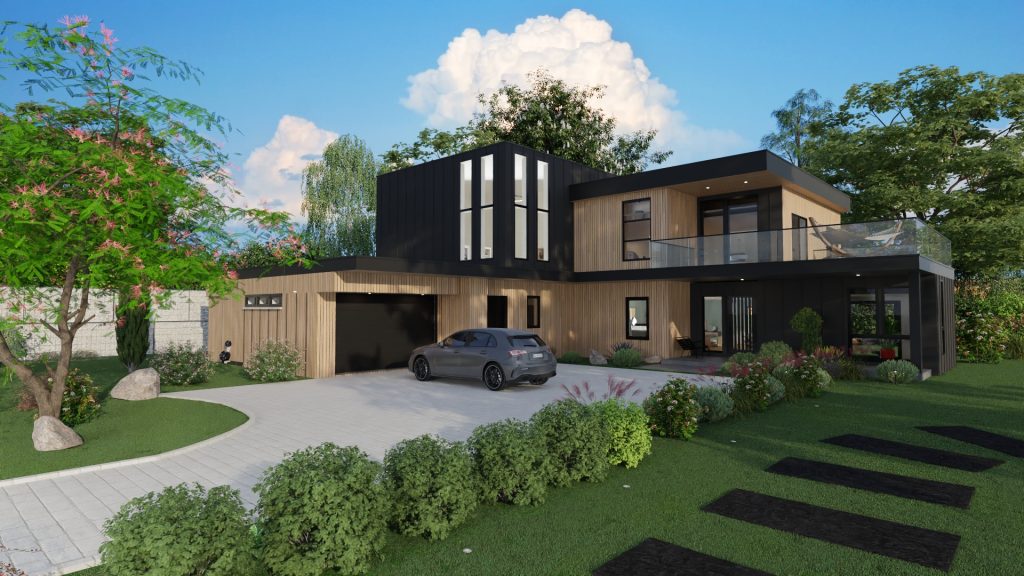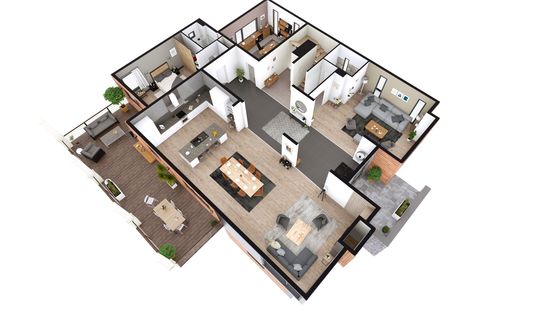Design-build construction has turned into something of a buzzword in recent years. That’s likely due in part to the clear benefits of this construction project management method.
- But what exactly is design-build construction (also known as design-construct or single-source responsibility)?
- What are the pros of design-build over other project delivery methods like design-bid-build?
If you’re a home builder or designer and are interested in growing your business while providing the best service possible to your clients, it’s important to consider the answers to those questions.
This 7-minute read will teach you everything you need to know about the design-build project delivery method and tips for running a design-build construction company.
Let’s start with a quick look at the basics.
What Is Design-Build Construction?
Design-build construction is a project delivery method where one company handles the entire construction project from design through construction. That means the design team and construction team work together under one contract.
Design-build construction is all about unifying the many processes and project team members involved in bringing a home from design to completion.
This method of home construction is the primary alternative to what’s known as design-bid-build construction.
Design bid build separates the design and construction processes in a way that involves multiple contracts and multiple professionals or companies working on the same project. (See more about it in the next section.)
Once a relatively unknown construction method, design-build construction has risen sharply in popularity in recent years. In fact, roughly 47 percent of construction dollars spent in the United States are spent on design-build projects.
What Is Design-Bid-Build Construction?
Despite huge increases in the market share of design-build projects, design-bid-build construction is still considered the traditional standard in modern construction.
The design-bid-build process is broken down into two main phases:
- The design and project planning phase
- The construction phase.
Between those two phases is the bidding, where the project goes up for bids and contractors reach out to the owner to compete for the project.
In the first phase, the owner and designer collaborate on not only the design of the building but also the projected timeline, materials, and various other factors. After the bidding process, the project goes to the best-bidding construction company or contractor, who then takes the specs and plans and runs with them.

How Does Design-Build Construction Differ from Traditional Approaches and Why Has it Taken Off?
Here’s the basic way they are different.
- Design-Build Projects: A design-build construction company will oversee the design process and building construction from start to finish.
- Design-Bid-Build Projects: A design company does the design and a separate construction company builds the home.
But the differences between the two methods go a lot deeper than that, particularly for the day-to-day experiences of both the companies and the customers.
For example, design-build construction companies have to employ both home designers and construction professionals who can do amazing work with both things. Meanwhile, customers deal with only a single company when they go through the design-build process.
Instead of having to communicate with another company to make sure all of the specifications of the design are coming through clearly and everyone has the same understanding of the blueprints, a design-build company has internal discussions to make sure everyone from each department is on the same page.
Benefits of the Design-Build Construction Approach
The design-build construction approach offers several key advantages.
Reduced Costs
For both owners and companies, the build-design approach offers serious cost savings. That’s largely thanks to the unified nature of the process.
The company and customer establish a single overall project budget at the very beginning of the process, so there are no surprises for the customer later on. And because no time is wasted communicating between companies or setting up for project proposals, overall costs for the involved company go way down.
Ultimately, a single company is left with responsibility for the project. On both ends of the equation, that means the team works together to keep costs down — both to stay within budget and increase profit margins.
Increased Project Speed
Design-build construction streamlines most home-building projects because it lets you skip certain steps of the design-bid-build method.
For example, a request for bids can add weeks to a project’s timeline. But with build-design construction, you don’t request bids because the company that designed the building builds the building.
Additionally, the design-build process reduces the potential for project delays due to miscommunications between the design company and the construction company.
Reduced Risk
The design-bid-build model separates the various project teams, including not only design and construction but dozens of potential subcontractors.
These separate teams are only working on their portion of the building, and they will usually do what’s best for them — NOT the overall project. That means accidents and setbacks are more likely to happen and put the entire project at risk.
But when one company is handling the entire project, they assume all the risk for the project.
- For customers, that means that there is one company that holds all the responsibility for delays, setbacks, injuries, and losses. Instead of having to track down the responsible team or contractor, they simply turn to their design-build provider to look for answers.
As the company, you control all of the risks. That means you’re not going to be put at risk by someone else’s company and you can take steps to reduce the financial and legal liabilities associated with the project.
Decreased Administrative Burden
A lot of administrative work goes into any construction project for both builders and the people who are paying them. But when the project in question is a design-build project, the amount of administrative work is less compared to what’s required for a design-bid-build project.
Why? It mainly comes down to…
- Communication
- Contract management.
With design-build, there’s a single point of contact for the customer and a single contract to manage. For the design-build construction company, there’s no risk of stepping on the toes of another involved contractor, and all communication comes from either the customer or internal company departments.
Greater Collaboration & Relationships
Collaboration leads to innovation. That’s because more minds working together are more likely than single minds working separately to catch mistakes, do things right, and find the best approach.
Design-build is a collaborative approach to construction.
Instead of a single team, such as the design team, working on the design with no outside input, you have a design and construction team working together on the project and for the same company.
That means the construction team has more power to speak up when a design move could cause construction delays or add expenses.
Easier Communication for Greater Success
Many of the benefits of design-build construction revolve around the following point…Communication is better when a single company is responsible for the design and construction of a building. And better communication leads to better outcomes.
Design-Build Disadvantages
Although most consider the pros to outweigh the cons, there are a few possible disadvantages to the design-build process.
It’s important to understand these since most of the cons fall on the customer side of things. If you can find ways to mitigate these disadvantages, you’ll have a better chance of landing more clients.
- Lack of flexibility: Because your clients are bundling services and putting all their eggs in one basket, you need to make sure they can trust you. Once they’ve hired you to start the design, they don’t have the flexibility to go with another contractor for the construction phase.
- Could be more expensive: Because the project isn’t won based on the lowest bid, your clients may feel that they’re not getting the best deal. So be ready to show them how they’re saving in other ways.
Less creativity: When you combine the design and construction into one contract, it’s tempting to want to rush through the design phase so you can get to construction as fast as possible. So make sure to offer plenty of rounds of feedback and revisions to avoid stifling creativity.
Phases of the Design-Build Process
Design-build construction may be a simpler alternative to the more traditional construction methods, but that doesn’t mean the entire process is simple. To be successful with the build-design construction process, you need to break it down into steps.
That’s exactly what we’ve done below. Here are five key phases of the design-build construction process.
1. Team Selection
Phase one of the design-build process involves the future home or building owner finding the right design-build construction company. This process may involve interviewing several companies to find one that fits your vision, desired level of experience, capabilities, and budget.
Cost isn’t the only factor here, but it is an important one. However, keep in mind that you won’t have a great idea of the cost until you have a more concrete design in hand.
Also, remember that you often get what you pay for in design-build construction. The best companies know what they are worth and charge accordingly.
2. Pre-construction
Pre-construction is an important phase in the process for nearly any construction method, but it’s particularly important in the design-build construction industry. That’s because this is when owners start collaborating with their chosen company, and the company has a chance to show their expertise, value, and attention to detail.
This phase often involves a ton of questions coming from both sides of the equation.
- Customers ask the builder technical questions
- The builder asks questions to understand the customer’s needs and vision for the project.
This is also the phase where all of the internal teams at the design-build construction company begin collaborating to plan the project and its timeline.
Contractors, engineers, designers, architects, and various other professionals within the company will begin offering feedback on the rough design of the building and determining everything that must be done before construction on the project can start.
3. Architectural Design
With the project’s timeline and scope laid out, the build-design construction company can begin working on the architectural design of the building. This process will build on the rough initial design work done during the pre-construction phase.
The architect or designer gets to work with sophisticated floor plan software like Cedreo. The other teams within the company begin offering feedback on each stage of the design, searching for ways to reduce costs, save time, or prevent setbacks.

The result of this phase is an approved set of architectural drawings for the home or commercial building. Before that can happen, the customer must review the design the company has come up with, offer feedback, and approve the final version.
With design approval, the final step in the architectural design phase is to set the specific timeline for construction and establish expectations with the client.
4. Construction
Sometimes, the initial phases of construction can begin toward the end of the architectural design phase. Completing certain parts of the construction process, such as breaking ground or laying the foundation, before the design is fully approved can save a ton of time.
But whether that has happened with your project or not, the construction phase is where the real building work begins in full.
Relying on the timeline set in the previous phase, the construction team will begin pouring its time and effort into the construction of the building. Materials and subcontractors will already be sourced, so the most time-consuming part of this phase is the actual construction.
This is a part of the design-build process that showcases how much simpler this approach can be. That’s because this is when the single point of contact within the single design-build company can shine.
They direct questions and concerns to the appropriate departments, make sure every query is addressed, and ensure the project is on time and within budget at every turn.
Teams also work together during this phase to overcome the inevitable challenges and setbacks that will pop up. And since they’re all working together, instead of choosing only the solution that is best for their team, they land on the solution that’s best for the whole company — and, ultimately, the customer.
5. Post-construction
Post-construction begins as soon as the construction is complete. This is when the owner gets presentations and Post-construction begins as soon as the construction is complete. This is when the owner gets presentations and walk-throughs to make sure everything is as they expected, and the design-build company addresses any issues or questions.
FAQ of Design-Build Construction
1. Is the design-build method more expensive than the traditional route?
No. The design-build process may be trendy right now, but that doesn’t mean it’s always more expensive. Across the entire project, it can be less expensive than the design-bid-build process because it eliminates much of the inefficiency involved in separating the design and build teams.
2. By going the design-build route will I lose control and choice?
No. The best design-build construction companies will allow you to weigh in on choices on almost every aspect of your project, such as the materials used, and, of course, the design of the building.
3. Is there bidding on design-build projects?
There is no competitive bidding in design-build projects. While this saves time and resources, it may mean that for certain parts of the project, the owner may not get the most competitive price.
Final Thoughts
Design-build construction is growing in popularity, and it is easy to see why. The method offers improved efficiency, streamlined communication, and reduced timelines than design-bid-build construction. And those benefits extend to both customers and companies.
As the popularity of design-build construction increases, so does the competitiveness of these projects. Contractors are going to great lengths to compete for these high-value jobs, and any small edge in the selection process can result in millions more in revenue.
Cedreo helps you get and maintain that edge.
A simple, intuitive, and powerful custom home design software, Cedreo helps contractors like you to close more deals with the design-build approach.
- Design the home within hours
- Generate photorealistic 3D renderings
- Immediately incorporate feedback
- Quickly export blueprints and construction documents for use in the field.
Cedreo provides a simple and effective solution for the modern design-build construction firm.
Interested? Try Cedreo today, for FREE.



